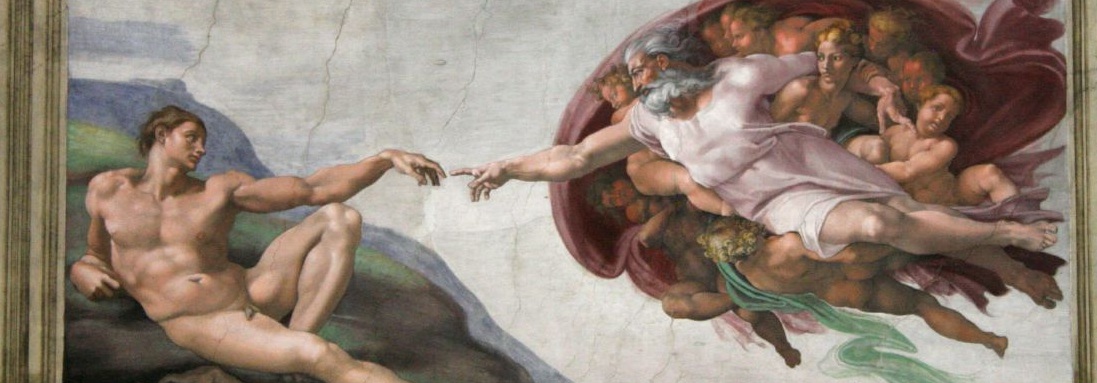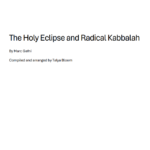Prayer: a pointing-out instruction for God
By Marc Gafni
We are all despearate for communion. It is what makes our lives worth living. Communion is the movement from loneliness to loving. It is the experience of being held and received.
We are all systematically mis-recognized. To be recognized is to be seen. To be seen is to be loved. To be love is to be in communion. It is only when we are seen that we are called to the fullness of our glimmering beauty as unique incarnations of the the divine treasure. It is only when we are seen that we feel moved the personal evolutionary impulse that lives in us to give the unique gifts that are only ours to give and that are desperately desired by the all that is.
To be in communion is to know that Your deed is God’s need. It is the realization of communion that gives us joy and calls us to evolutionary responsibility.
Communion as God in the 2nd Person View
‘Communion’ is the name that Kabbalah scholar Gershom Sholem gave to the experience of God in the second person. This is the inner experience of a human being who is not merged with the divine but rather stands in relation to God. This state of relatedness to God is the essence of Hebrew biblical consciousness. According to Scholem, it defines Hebrew mystical consciousness as well.
God in second-person perspective is all about relationship–whether it is the relationship of a servant to his master, a lover to her beloved, a relationship with a partner or even a relationship with a friend. All these can be ways of “relating” to God, and all of these models of relationship find expression in Hebrew wisdom teachings. All are ways of approaching God in the second person.
The most powerful form of God in the second person is almost certainly the prayer experience. It is told that when Hassidic master Levi Yitzchak of Berditchev used to pray, he would begin to say the standard liturgical form of blessing–“Baruch Ata Adonai”, “Blessed are you, God.” Then he would break out of the formal mode of blessing, crying out in sheer joy, “YOU YOU…YOU …YOU!” He would lose himself in these words, repeatedly shouting in ecstasy, “YOU… YOU… YOU!!!”
This is the rapture of God in the second person. For Levi Yitzchak, the blessing is what the Buddhists call a ‘pointing-out instruction’. But the words point not to sunyatta or emptiness, but to God as a beloved Other.
Nachman of Bratzlav taught the spiritual practice of Hitbodedut. In one form, this meant walking alone in the forest “talking to God as you would to your friend.”
With “God in the second person,” we meet God and bow. With “God in the second person,” we meet God and partner. With “God in the second person,” we meet God and love. With God in the second person, we meet God and pray. The key to experiencing God in the second person is the encounter. It is the encounter with God in history, and in the lived reality of every human being, that is the essence of the “God in the second person” experience.
This is the God of prayer. The God of prayer is not a concept, but a realization. I recall a recent conversation with a well-known Buddhist teacher. He said to me, “how can a serious teacher like yourself believe in the dogma of prayer?” I asked him, “How can you believe in the dogma of awareness”? He said to me, “Awareness is not a dogma, it is a realization”. To which I responded, “Yes, of course it is. And so is prayer.”
He told me later that this simple pointing-out instruction shifted his entire relationship to prayer. Prayer is not a dogma. It is a realization of God in the second person. It is the felt sense that every place you fall, you fall into God’s hands. Not the god of the mythic, ethnocentric church or synagogue or mosque or temple. Not that God. Not the God that as a modern or post-modern skeptic, you do not believe in. The God you don’t believe in does not exist! Rather, God in second person is the personal face of Essence. It is the aspect of personal Essence that knows your name, and cares about every detail of your life.
Feel into the quality of the personal that lives in you, as you and through you. Remember, perhaps, a time when you felt alienated in a relationship and you said to your partner, ‘I feel you are being so impersonal.’ Or when you critiqued some dimension of society as being too impersonal. Inherently, you sensed that Essence has a personal quality. This personal Essence is beyond the grasping of the skin-encapsulated ego, which still believes itself to be separate from all that is. It is rather the personal quality of Source.
Levi Isaac of Berdichev in the story above did not faint in ecstasy because he was moved by the dogma of a personal God. Rather, he fainted in ecstasy at the felt experience and realization of the lived encounter, in that very moment, with the personal face of God. It is the experience of God in the second person that inspires prayer. So, prayer is not an act of dogma, or a religious obligation.
True prayer is the ecstatic realization of God in the second person. Prayer is an expression of the radically personal nature of enlightenment–the place in which the personal unique self talks to the personal God. In prayer, the personhood of God meets the personhood of a human being.
It is the flight of the lonely one to the Lonely One. Or as Hasidic master Ephraim of Sudykov said, the meeting of misunderstood man with misunderstood God. Human being and God meet — realizing that they are both strangers in the land. They up in a friendship in which both are liberated and redeemed from loneliness.
We are used to thinking of Essence in impersonal terms. In the usual thinking of the spiritual world, the human being has a personality or separate self, which is transcended in enlightenment and melts into the impersonal Essence of all-that-is. This, however, is only a part of the story. As I have described in depth in my book, Your Unique Self: The Future of Enlightenment, there is a personal Essence, which is beyond the impersonal.
To truly understand and embody the interior face of Essence, one needs to move through four core levels of consciousness.
- Level One is re-personal. This occurs before the emergence of an individuated separate self.
- Level Two occurs when the Pre-personal emerges as the Personal Self. This is the important level of separate self, ego and personality.
- The Third Level is when the personal—-in a healthy and non-dis-associative process–is transcended and included into the Impersonal. This is the classic state of enlightenment, which appears in all the great traditions. The personal is trance-ended. You end the trance of the personal self, and realize that you are part of the vast impersonal Essence of all-that-is. It is impersonal in the sense that is beyond the individual personality of any one person. It is the seamless coat of the universe of which you are a part.
However, that is not the end of the story. The seamless coat of the universe is seamless, but not featureless. Some of its features are expressed uniquely as your personal incarnation of Essence. Your irreducible uniqueness is an expression of the personal quality of the divine, beyond the impersonal.
In this stage of development, the impersonal then reveals its personal face. You experience the personal face of the vast impersonal divine Essence that suffuses, animates and embodies all that is. Here, we are not speaking of a kind of Santa Claus God-in-the-sky. That is merely your personality, or perhaps your your mother’s or father’s personhood, writ large!
Rather this fourth and most profound level of consciousness is the personal face of all-that-is, the aspect of universal Essence that knows your name and cares about your life. It is the divine Mother who holds you in her loving embrace, comforting you, yet challenging you to your greatness at the very same moment.
The second face of God is an infinity of intimacy, which invites your approach and your prayer. Prayer and intimacy are almost synonymous words. The personal face of Essence, which knows your name, affirms the infinite dignity, value and adequacy of your personhood, even as your prayer affirms the dignity of personal needs. Our praise and our petition, our confessions and even our crying out in need are all addressed to the second person of God, which is invoked through the sacred art of prayer. Prayer is our way of initiating a conversation with, and thereby invoking, the infinitely gorgeous face of the personal God, God in the second person.
Pictured: Levi Yitzchak of Berditchev
Note: This post was originally published on May 8, 2012.









